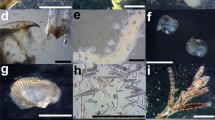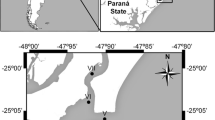Abstract
Herein, we characterize a symbiotic relationship between the scyphomedusa Lychnorhiza lucerna and the decapod crustacean Libinia spinosa in Río de la Plata, South America. Of 843 specimens of L. lucerna examined during the study, 69 (8.2 %) hosted L. spinosa within subgenital spaces. The broad spatial and temporal scale of the study, together with the large number of observations made, confirm an association between the two species. Medusae having crab associates were mature and larger than those lacking such symbionts. Adult crabs of both sexes, as well as juveniles and soft-shell individuals, were found as associates of medusae. Analysis of crab stomach contents revealed the presence of nematocysts and copepod remains. Our results suggest that medusae provide protection and possibly access to food for crabs. Benefits related to transportation were not clear and need further evaluation. Crabs of L. spinosa may acquire their scyphozoan symbionts either as larvae planktonic stages or as adult crabs attaching to jellyfish when aggregating close to bottom.





Similar content being viewed by others
References
Alvarez Colombo G, Mianzan H, Madirolas A (2003) Acoustic characterization of gelatinous-plankton aggregations: four case studies form the Argentine continental shelf. ICES J Mar Sci 60:650–657
Arai MN (1997) A functional biology of Scyphozoa. Chapman & Hall, London
Baeza JA, Stotz W (1998) Selección del hábitat durante el asentamiento larval de Allopetrolisthes spinifrons (H. Milne Edwards, 1837) (Decapoda: Porcellanidae) en su hospedador habitual Phymactis clematis (Drayton, 1846) y dos nuevos hospedadores. Rev Biol Mar Val 30:255–264
Baeza JA, Thiel M (2000) Host use pattern and life history of Liopetrolisthes mitra, a crab associate of the black sea urchin Tetrapygus niger. J Mar Biol Assoc UK 80:639–645
Beers JR (1966) Studies on the chemical composition of the major zooplankton groups in the Sargasso Sea off Bermuda. Limnol Oceanogr 11:520–528
Boschi EE (1964) Los crustáceos decápodos Brachyura del litoral bonaerense (R. Argentina). Bol Inst Biol Mar 6:1–76
Boschi EE (2000) Species of decapod crustaceans and their distribution in the American Marine Zoogeographic Provinces. Rev Invest Des Pesq 13:7–136
Browne JG, Kingsford MJ (2005) A commensal relationship between the scyphozoan medusae Catostylus mosaicus and the copepod Paramacrochiron maximum. Mar Biol 146:1157–1168
Castro P (1978) Settlement and habitat selection in the larvae of Echinoecus pentagonus (A. Milne Edwards), a brachyuran crab symbiotic with sea urchins. J Exp Mar Biol Ecol 34:259–270
Coleman N (1977) A field guide to Australian marine life. Rigby, Adelaide
Corrington JD (1927) Commensal association of a spider crab and a medusa. Biol Bull 53:346–350
Curl H (1962) Standing crops of carbon, nitrogen, and phosphorous and transfer between trophic levels, in continental shelf waters south of New York. Rapp P.v Réun Cons Int Explor Mer 153:183–189
Garth JS, Abbott DP (1980) Brachyura: the true crabs. In: Morris RH, Abbott DP, Haderlie EC (eds) Intertidal invertebrates of California. Stanford University Press, Stanford, pp 594–630
Giberto DA (2008) Estructura de la comunidad bentónica y ecología trófica de Sciaenidae (Pisces: Osteichthyes) en el estuario del Río de la Plata. PhD Thesis, Universidad Nacional del Comahue
Giberto DA, Bremec CS, Acha EM, Mianzan H (2004) Large-scale spatial patterns of benthic assemblages in the SW Atlantic: the Río de la Plata estuary and adjacent shelf waters. Estuar Coast Shelf S 61:1–13
Graham WM (1989) Long-term association of Cancer sp. crabs with Scyphomedusae in Monterey Bay. V Int Coeletenterate Biol, Southampton 5:38–39
Graham WM (1994) The physical oceanography and ecology of upwelling shadows. PhD Thesis, University of California
Gutsell JS (1928) The spider crab, Libinia dubia, and the jellyfish Stomolophus meleagris, found associated at Beaufort, North Carolina. Ecology 9:358–359
Hacker SD, Madin LP (1991) Why habitat architecture and color are important to shrimp living in pelagic Sargassum: use of camouflage and plant-part mimicry. Mar Ecol Prog Ser 70:143–155
Harbison GR, Biggs DC, Madin P (1977) The association of Amphipoda Hyperiidea with gelatinous zooplankton. II. Associations with Cnidaria, Ctenophora and Radiolaria. Deep Sea Res 24:465–488
Hyman LH (1940) The invertebrates: Protozoa through Ctenophora. McGraw-Hill, New York
Jachowski R (1963) Observations on the moon jelly, Aurelia aurita, and the spider crab, Libinia dubia. Chesapeake Sci 4:195
Janssen J, Harbison GR (1981) Fish in salps: the association of squaretails (Tetragonurus spp.) with pelagic tunicates. J Mar Biol Assoc UK 61:917–927
Larson R (1986) Pelagic Scyphomedusae (Scyphozoa; Coronatae and Semaeostomeae) of the Southern Ocean. Biol Antarct Seas XIV, Antarct Res Ser 41:59–165
Larson RJ (1990) Scyphomedusae and Cubomedusae from the Eastern Pacific. Bull Mar Sci 47:546–556
Madin LP, Harbison GR (1977) The associations of amphipods Hyperiidea with gelatinous zooplankton. I. Association with Salpidae. Deep-Sea Res 24:449–463
Martin JW, Kuck HG (1991) Faunal associates of an undescribed species of Chrysaora (Cnidaria, Scyphozoa) in the Southern California Bight, with notes on unusual occurrences of other warm water species in the area. Bull South Calif Acad Sci 90:89–101
Melo GAS (1996) Manual de Identificação dos Brachyura (caranguejos e siris) do Litoral Brasileiro. Plêiade, São Paulo
Mianzan HW, Cornelius PFS (1999) Cubomedusae and scyphomedusae. In: Boltovskoy D (ed) South Atlantic Zooplankton. Backhuys Publishers, Leiden, pp 513–559
Mianzan HW, Olague G, Montero R (1988) Scyphomedusae de las aguas uruguayas. Spheniscus 6:1–9
Mianzan HW, Lasta C, Acha EM, Guerrero R, Machi G, Bremec C (2001) The Río de la Plata Estuary, Argentina-Uruguay. In: Seeliger U, Lacerda LD, Kjerve B (eds) Ecological studies: Coastal marine ecosystems of Latin America. Springer, Berlin, pp 185–204
Morandini AC (2003) Estrutura populacional de Chrysaora lactea e Lychnorhiza lucerna (Cnidaria; Scyphozoa) em amostras de plâncton, com a redescrição das espécies. PhD Thesis, Instituto de Biociências da Universidade de São Paulo
Moreira MGBS (1961). Sobre Mastigias scintillae sp. nov. (Scyphomedusae, Rhizostomeae) das costas do Brasil. Boletim do Instituto Oceanográfico da Universidade de São Paulo, São Paulo 11:5–30
Morton B (1989) Partnerships in the sea. Hong Kong University Press, Hong Kong
Nishikawa J, Thu HH, Ha TM, Thu PT (2008) Jellyfish fisheries in northern Vietnam. Plankton Benthos Res 3:227–234
Nogueira JM, Haddad MA (2005) Lychnorhiza lucerna Haeckel (Scyphozoa, Rhizostomeae) and Libinia ferreirae Brito Capello (Decapoda, Majidae) association in southern Brazil. Rev Bras Zool 22:908–912
Ohtsuka S, Koike K, Lindsay D, Nishikawa J, Miyake H, Kawahara M, Mulyadi, Mujiono N, Hiromi J, Komatsu H (2009) Symbionts of marine medusae and ctenophores. Plankton Benthos Res 4:1–13
Ohtsuka S, Kondo Y, Sakai Y, Shimazu T, Shimomura M, Komai T, Yanagi K, Fujita T, Nishikawa J, Miyake H, Venmathi Maran BA, GO A, Nagaguchi K, Yamaguchi S, Dechsakulwatana C, Sriniu K, Putchakarn S, Mulyadi, Mujiono N, Sutomo Yusoff FM (2010) In situ observations of symbionts on medusae occurring in Japan, Thailand, Indonesia and Malaysia. Bull Hiroshima Univ Mum 2:9–18
Panikkar NK, Prasad RR (1952) On an interesting association of ophiuroids, fish and crab with the jellyfish Rhopilema hispidum. J Bombay Nat Hist Soc 51:295–296
Phillips PJ, Burke WD, Keener EJ (1969) Observations on the trophic significance of jellyfishes in Mississippi Sound with quantitative data on the associative behavior of small fishes with medusae. Trans Am Fish Soc 4:703–712
Rohde K (2005) Marine parasitology. Csiro Publishing National Library of Australia, Australia
Rountree RA (1983) The ecology of Stomolophus meleagris, the cannon ball jellyfish, and its symbionts, with special emphasis on behavior. PhD Thesis, University of North Carolina
Sal Moyano MP, Gavio MA, Maggi MD (2011) Morphometric and gonad maturity of the spider crab Libinia spinosa (Crustacea: Brachyura: Majoidea: Epialtidae) in Argentina. J Mar Biol Assoc UK 91:837–844
Scelzo M, Martinez Arca J, Lucero N (2002) Diversidad, densidad y biomasa de la macrofauna componente de los fondos de pesca “camarón-langostino” frente a Mar del Plata, Argentina (1998–1999). Rev Invest Des Pesq 15:43–66
Schiariti A (2008) Historia de vida y dinámica de poblaciones de Lychnorhiza lucerna (Scyphozoa) ¿Un recurso pesquero alternativo? PhD Thesis, Universidad de Buenos Aires
Schiariti A, Kawahara M, Uye S-I, Mianzan HW (2008) Life cycle of the jellyfish Lychnorhiza lucerna, (Scyphozoa: Rhizostomeae). Mar Biol 156:1–12
Schiariti A, Christiansen E, Morandini AC, da Silveira F, Giberto D, Mianzan HW (2012) Reproductive biology of Lychnorhiza lucerna (Cnidaria: Scyphozoa: Rhizostomeae): individual traits related to sexual reproduction. Mar Biol Res 8:255–264
Shanks AL, Graham WM (1988) Chemical defense in a scyphomedusa. Mar Ecol Prog Ser 45:81–86
Shenker JM (1985) Carbon content of the neritic scyphomedusa Chrysaora fuscescens. J Plankton Res 7:169–173
Sokal R, Rohlf F (1999) Introducción a la Bioestadística. Reverté, Barcelona
Suzuki K (1965) On a young crab found near the oral arms of the jellyfish, Rhopilema esculenta Kishinouye. Res Crustac (Kokakurui no Kenkyu) 2:77–82
Towanda T, Thuesen EV (2006) Ectosymbiotic behavior of Cancer gracilis and its trophic relationships with its host Phacellophora camtschatica and the parasitoid Hyperia medusarum. Mar Ecol Prog Ser 315:221–236
Trott LB (1972) The portunid crab Charybdis feriatus (Linnaeus) commensal with the scyphozoan jellyfish Stomolophus nomurai (Kishinouye) in Hong Kong. Crustaceana 23:305–306
Tunberg BG, Reed SA (2004) Mass occurrence of the jellyfish Stomolophus meleagris and an associated spider crab Libinia dubia, eastern Florida. FL Scientist 67:93–104
Vaz Ferreira C (1972) Relaciones de conveniencia entre Libinia spinosa Milne Edwards (Decapoda, Brachyura) y Discomedusae. Bol Soc Zool Uruguay 2:64–66
Wrobel D, Mills CE (1998) Pacific coast pelagic invertebrates. Sea Challengers, Monterey
Zamponi MO (2002) The association between medusa Lychnorhiza lucerna (Scyphomedusae, Rhizostomeae) and the decapod Libinia spinosa (Brachyura, Majidae) recorded for the first time in neritic waters of Argentina. Russ J Mar Biol 28:267–269
Acknowledgments
We wish to thank Fabián Acuña for the help in identification of the anemone species. We gratefully acknowledge Dr. Dale Calder for his help on English Grammar and Style, which highly improved this manuscript. This work was partially funded by INIDEP and FONCyT PICT 02200. This is INIDEP contribution No 1723.
Conflict of interest
The authors declare that they have no conflict of interest.
Ethical standards
The methods and experiments comply with current laws of the country in which they were performed.
Author information
Authors and Affiliations
Corresponding author
Additional information
Communicated by J. Purcell.
Rights and permissions
About this article
Cite this article
Sal Moyano, M.P., Schiariti, A., Giberto, D.A. et al. The symbiotic relationship between Lychnorhiza lucerna (Scyphozoa, Rhizostomeae) and Libinia spinosa (Decapoda, Epialtidae) in the Río de la Plata (Argentina–Uruguay). Mar Biol 159, 1933–1941 (2012). https://doi.org/10.1007/s00227-012-1980-z
Received:
Accepted:
Published:
Issue Date:
DOI: https://doi.org/10.1007/s00227-012-1980-z




